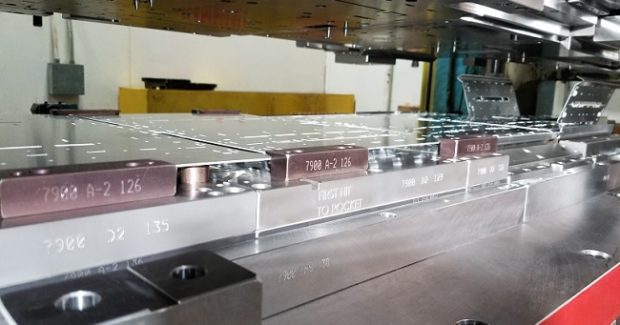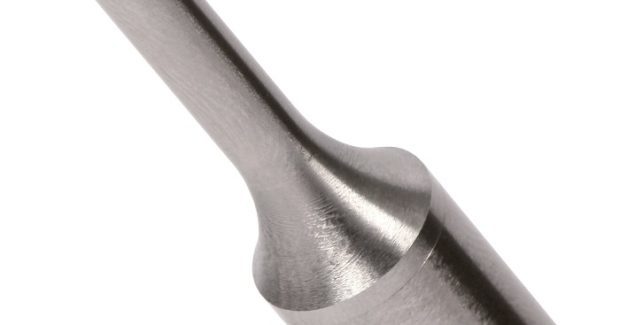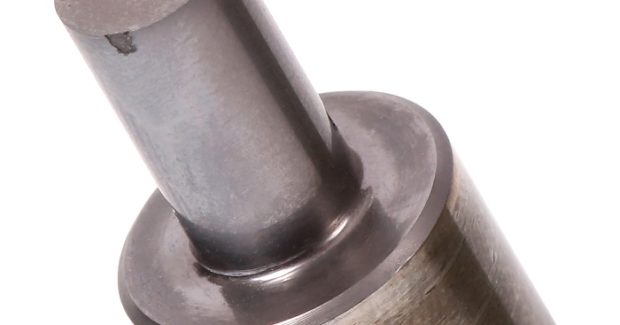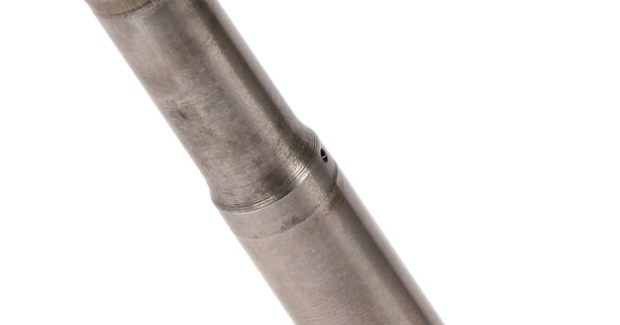
Deliberately pull a die out of the stamping press for tool maintenance even though it is still producing perfect parts? That’s right. Don’t wait for that next emergency to shut everything down to put out fires. You can actually reduce downtime by regularly scheduling preventive tool maintenance that provides longer tool life, fewer scrapped parts and improved productivity.
Posted: February 13, 2019




The frequency of scheduled maintenance depends on the material being stamped, the quantities being run, and the production requirements of the customer. A tool running mild steel runs much longer between maintenance than one running a stainless steel or one of the new alloys that can be very abrasive and have higher tonnage ratings. Whenever possible, schedule maintenance when the tool is not in use to minimize downtime. During longer runs or when stamping tougher materials, a punch may need sharpening mid-run to prevent damage and maintain part quality. (first view)
The frequency of scheduled maintenance depends on the material being stamped, the quantities being run, and the production requirements of the customer. A tool running mild steel runs much longer between maintenance than one running a stainless steel or one of the new alloys that can be very abrasive and have higher tonnage ratings. Whenever possible, schedule maintenance when the tool is not in use to minimize downtime. During longer runs or when stamping tougher materials, a punch may need sharpening mid-run to prevent damage and maintain part quality. (second view)
The most common method for sharpening a punch is to surface grind. Cracks start on the surface of the punch. Without adequate coolant, excessive heat is generated on the punch tip, creating a micro-fracture (shown here) that will be unseen until the tool is back in the press making parts and failing prematurely. Far too many punch failures are caused by improper grinding method or not using coolant.
Tooling with buildup or galling (shown here) on it increases the risk of running parts not to specification, resulting in scrapped parts. The longer a punch showing signs of galling or buildup runs, the worse the wear gets. If the wear becomes too deep or extensive, maintenance is no longer viable. The tool must be replaced.

If the thought of purposely pulling a tool and die set out of the stamping press to perform maintenance when it is still producing perfect parts sends shivers down your spine, you are not alone. After all, if the press isn’t stroking, you’re not making money. However, regularly scheduling preventive maintenance for your tool and die sets might mean the difference between maintenance and repair – or worse, replacement. There are two main reasons for scheduling preventive tool and die maintenance: First, when tooling gets dull or has buildup or galling on it, you increase the risk of running parts that are not to specification, resulting in scrapped parts. Second, the longer you run a punch that is dull or showing signs of galling or buildup, the worse the wear is going to get. If the wear becomes too deep or extensive, maintenance will no longer be a viable option. The tool will need to be replaced.
It is not uncommon for a punch to be able to be sharpened multiple times (two, three, even four times) before you have to replace it, as long as you catch the wear before it gets extensive. Continuing to run worn punches will also lead to faster wear in other parts of the tool. In progressive applications, if a burr forms on the part it may cause the die feeder to misfeed resulting in a missed hit, which can cause tremendous damage inside of a die or even blow it apart. Scrapped parts mean you either have to try to rework those parts and make them usable with time-consuming secondary operations, or you’ve lost all of that production time and have to go back and rerun all of those parts after the tool has been repaired. Total tool failure means you have to order (and wait for) a new punch. With lead times that can be more than just a few days for special punches, that can amount to a significant delay. Either way, you’re out a lot of time and money.
Regularly scheduling preventive maintenance can eliminate these issues and lead to improved productivity and longer tool life. When planned carefully, preventive maintenance can actually reduce downtime. Determining how frequently you need to schedule maintenance will depend on the material you are stamping, the quantities that are run, and the production requirements of your customer. A tool running mild steel will run a lot longer between maintenance than a tool running a stainless steel or one of the new alloys, which can be very abrasive and have higher tonnage ratings. Whenever possible, maintenance should be scheduled when the tool is not in use to minimize downtime. However, there are instances during longer runs or when stamping tougher materials that a punch may need to be sharpened mid-run in order to prevent damage and maintain the quality of the part being produced.
Stamping houses that run the same parts all the time may purchase more than one tool that produces a single part. This makes it possible to run one tool that has already been sharpened and maintained while the other tool is out for scheduled maintenance, resulting in nearly continuous press uptime. Depending on the size of the stamping house and/or the quantity of parts being produced, purchasing multiples of the same tooling may be cost prohibitive. Nevertheless, scheduling and performing regular maintenance is still more cost effective than waiting for a worn punch to produce scrap parts or fail entirely. A short amount of planned downtime for maintenance is far less disruptive then shutting a press down unexpectedly to deal with a broken tool.
Even with a maintenance schedule, it’s important to be aware of signs that maintenance is needed. If you notice burrs on the part or if the quality of finished parts is less than expected, tooling should be inspected for wear. The same is true if you suddenly encounter feeding issues with a progressive die. Sound is another indicator of wear: New stamping presses with tonnage meters that automatically increase tonnage as the tooling gets more and more worn will get noticeably louder as the tonnage goes up. Of equal importance to scheduling maintenance is ensuring that tooling is inspected and maintained properly. Every time a set of tooling is taken out of the press for maintenance it should get a thorough inspection of all of the working components.
Punches should be inspected for signs of wear and sent for sharpening. The most common method for sharpening a punch is to surface grind. Grinding wheels are made of many different grits and compounds that work well for different materials. Your tooling manufacturer can recommend the right combination for your punches. Always use coolant when grinding a punch to prevent smoking the tooling. Cracks start on the surface of the punch. Without adequate coolant excessive heat is generated on the punch tip, creating a micro-fracture that will be unseen until the tool is back in the press making parts and failing prematurely. Far too many punch failures are caused by improper grinding method or not using coolant. Die surfaces should be inspected, cleaned to remove debris and lubricated. Bearings and bushings need to be inspected regularly and lubricated or replaced as needed. Look for galling on cam surfaces and check springs for damage. Coils springs that are bent or nitrogen springs with worn seals should be replaced.
Deburr everything prior to reassembly, ensure that everything is flat, and check that the dowel pins are reinstalled carefully to avoid alignment issues that lead to early maintenance requirements. In the end, emergencies rarely improve productivity or save money. Eliminate the need to put out fires by scheduling regular preventive tool and die maintenance. You’ll notice longer tool life, fewer scrapped parts and improved productivity.

Jeremy Edson is a product manager for the stamping and tablet/compression divisions at Wilson Tool International, 12912 Farnham Avenue, White Bear Lake, MN 55110, 866-752-6531, [email protected] , www.wilsontool.com. He has more than 20 years of experience in the sheet metal tooling industry and has worked in a variety of roles ranging from machinist to product sales, supervisor of design and sales, as well as sport tooling program manager. He works with R&D, customers, and industry consumers to develop product solutions for some of the most demanding applications.
Whether you’re cutting metal, stamping, bending, folding, shearing or rolling up your sleeves to tackle other day-to-day jobs, ensuring equipment is in tip-top shape is critical to a Job Done RightTM. Thankfully, by giving equipment a little TLC, facilities can not only run smoothly, but also up the ante on efficiency and productivity.
Whether you’re cutting metal, stamping, bending, folding, shearing or rolling up your sleeves to tackle other.

Bossard will demonstrate its Ultrasonic Measuring Equipment and Junker’s Vibration Testing Machine.

This year’s theme, “Innovation. Inspiration. Impact,” highlights AWS’ dedication to connecting, collaborating, and shaping the future of the welding industry.

HEIDENHAIN is set to showcase its latest innovations in digital manufacturing at the International Manufacturing Technology Show (IMTS) 2024, from September 9-14 in Chicago, IL. Attendees are invited to explore HEIDENHAIN’s cutting-edge solutions at booth #339440 in the South Building,…